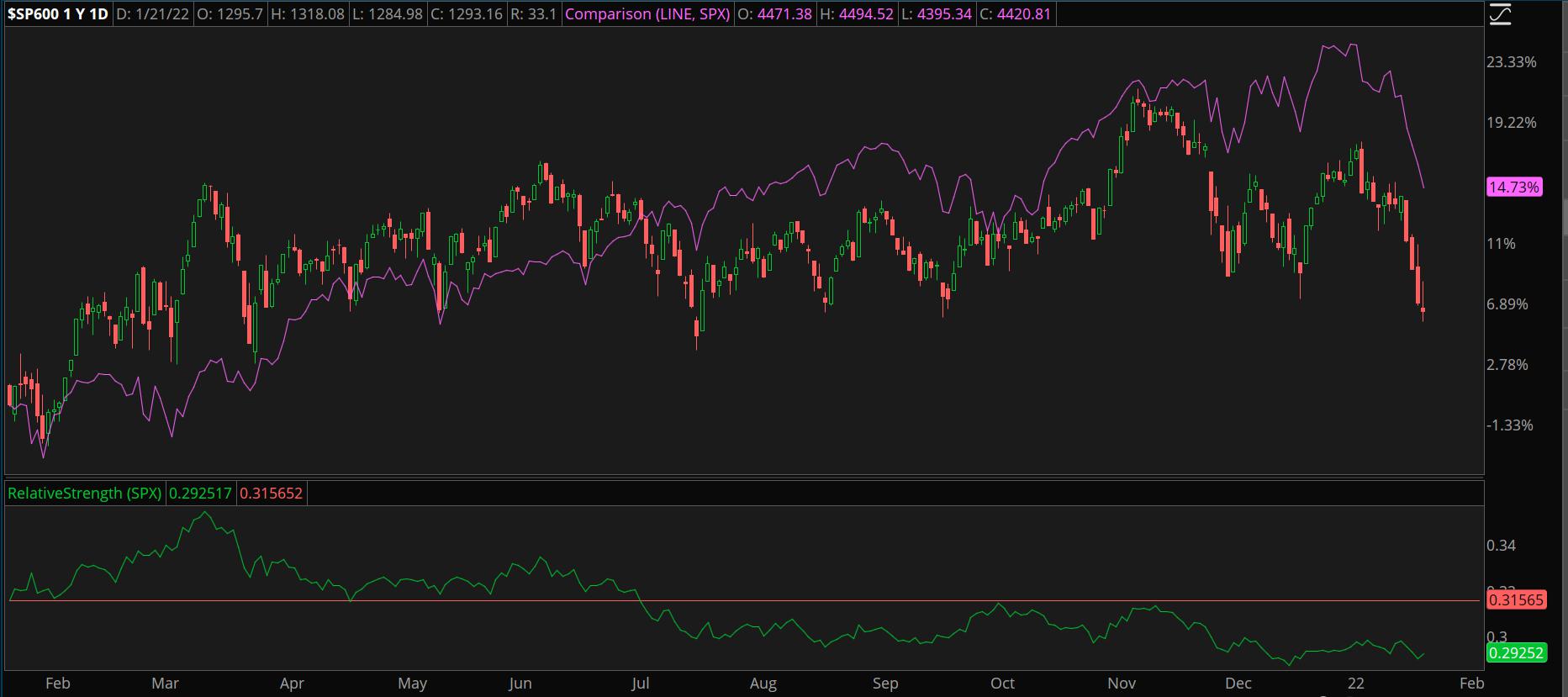
Key Takeaways:
- Netflix Pushes the Nasdaq Deeper into Correction Territory and Weighs on the S&P 500
- The VIX Flirts with 30, Which Was Often a Point of Reversal in 2021
- A Flight to Quality Doesn’t Have To Be for Large- and Mega-Caps Only
After Thursday’s close, Netflix (NFLX) announced better-than-expected earnings but projected major slowdowns in subscription growth. The stock immediately fell in after-hours trading, which translated into the next day. NFLX fell more than $100 per share and closed 21.79% lower on the day. The announcement was felt throughout the Nasdaq Composite ($COMP), which fell 2.72% and broke another level of support. The index has fallen further into correction territory and is now 13% off its all-time high. The Nasdaq’s next major level of support is about 13,000. If the index falls that far, it would near bear market territory because it would be down 20% from all-time highs.
Of course, the Nasdaq wasn’t the only index to fall on the news. The S&P 500 (SPX) dropped 0.75% with materials, consumer discretionary, and financials leading the way to the downside. Ecolab (ECL) was the worst-performing stock in the materials sector of the S&P 500, falling 8.48%. ECL is a world leader in water, hygiene, and disincentive products. It announced a 12% price increase globally. The price increase could hurt the company’s sales, which is probably driving the stock lower.
Major influencers to the S&P 500 and Nasdaq include stocks like Amazon (AMZN), which was down 5.95%, Apple (AAPL), which fell 1.28%, Microsoft (MSFT), which traded 1.85% lower, Meta (FB), which dropped 4.23%, and Alphabet (GOOGL), which closed 2.22% lower on the day. AMZN and FB are down more than 20% from their 52-week highs. AAPL, MSFT, and GOOGL aren’t down as much but still 10% to 13% lower from their highs. These stocks along with Netflix, which is down more than 40% from its all-time high, weigh heavily on these indices because of their sheer size.
As expected on a down day, defensive sectors including consumer staples, real estate, and utilities were the top performers and the only sectors to close in the green. Bonds also moved higher as the 10-year Treasury yield (TNX) dropped back to support around the 1.75% level.
MORE FOR YOU
The VIX (Cboe Market Volatility Index) was flirting with 30 throughout the day, which reflects the rising fear among investors. However, in an odd twist, over the last year, the 30 level has often signaled the end of a sell-off. Some sell-offs or corrections correlated with a VIX as high as 37. So, this development may be something to keep an eye on. At this point, we may start seeing investors trying to pick market bottoms next week. They’ll be looking to buy up potential bargains. For example, on Friday, investors were already buying up stocks like Peloton (PTON) and McDonald’s (MCD), which are a couple of stocks that have been pummeled by investors recently. This kind of buying could signal that the pendulum has swung too far in one direction.
Drift to Quality
When markets turn bearish, there’s often a “flight to quality” as investors sell riskier small-cap stocks in favor of large-cap blue-chip stocks. Investors are selling small-cap stocks, with the Russell 2000 (RUT) falling another 1.20% on Friday and adding to its four-day losing streak. While dropping 7.5% this week isn’t nothing to sneeze at, it’s not the panic selling expected during a bear market when investors are shunning risk.
In fact, the S&P 600 small-cap index tracks 600 “higher-quality” small-cap stocks, and it’s actually trading in-line with the S&P 500. Of course, both indices have recently moved lower, but quality can be in small-cap as well as large-cap stocks. Like the S&P 500, the S&P 600 has seen strength in the energy and financial sectors but weakness in information technology and communication.
So, while the lack of breadth signaled from the falling Russell 2000 is still concerning, it’s a stock pickers’ market. In my January Outlook article, I warned that this year could be the year of the active fund manager because investors have to search for quality. Unfortunately, quality flights cost a little extra—in time for searching and analysis.
CHART OF THE DAY: PLAYING WITH THE BIG BOYS. The S&P 600 ($SP600—candlesticks) small-cap index has … [+]
Selling Into the Close
The last hour of trading this week has been brutal on stocks, which makes you glad it was a shortened holiday week. However, traders often see last-hour sell-offs as bad sign for stocks for the following trading day. Traders often pick up the next day, where other traders left off on the previous day. However, there’s no guarantee that selling into the close on one day means stocks will sell off the next day. While it may mean something to a day trader, for many investors, selling into the close goes unnoticed.
Friday’s sell-off was complicated by options expiration, which is commonly a volatile day for stocks anyway. January expirations have a little more “umph” because of the expiration of LEAPS (long-term equity anticipation securities) options. The following Monday after expiration often has some residual volatility too because of – consequences related to expiration like stock assignment.
TD Ameritrade® commentary for educational purposes only. Member SIPC.







